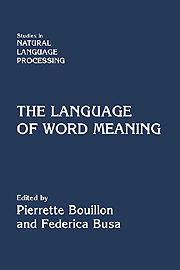Book contents
- Frontmatter
- Contents
- List of Contributors
- Preface
- Introduction: Word Meaning and Creativity
- Part I Linguistic Creativity and the Lexicon
- Part II The Syntax of Word Meaning
- 6 Introduction
- 7 Type Construction and the Logic of Concepts
- 8 Underspecification, Context Selection, and Generativity
- 9 Qualia and the Structuring of Verb Meaning
- 10 Sense Variation and Lexical Semantics: Generative Operations
- 11 Individuation by Partitive Constructions in Spanish
- 12 Event Coreference in Causal Discourses
- Part III Interfacing the Lexicon
- Part IV Building Resources
- Index
7 - Type Construction and the Logic of Concepts
Published online by Cambridge University Press: 07 October 2011
- Frontmatter
- Contents
- List of Contributors
- Preface
- Introduction: Word Meaning and Creativity
- Part I Linguistic Creativity and the Lexicon
- Part II The Syntax of Word Meaning
- 6 Introduction
- 7 Type Construction and the Logic of Concepts
- 8 Underspecification, Context Selection, and Generativity
- 9 Qualia and the Structuring of Verb Meaning
- 10 Sense Variation and Lexical Semantics: Generative Operations
- 11 Individuation by Partitive Constructions in Spanish
- 12 Event Coreference in Causal Discourses
- Part III Interfacing the Lexicon
- Part IV Building Resources
- Index
Summary
Abstract
I would like to pose a set of fundamental questions regarding the constraints we can place on the structure of our concepts, particularly as revealed through language. I will outline a methodology for the construction of ontological types based on the dual concerns of capturing linguistic generalizations and satisfying metaphysical considerations. I discuss what “kinds of things” there are, as reflected in the models of semantics we adopt for our linguistic theories. I argue that the flat and relatively homogeneous typing models coming out of classic Montague Grammar are grossly inadequate to the task of modeling and describing language and its meaning. I outline aspects of a semantic theory (Generative Lexicon) employing a ranking of types. I distinguish first between natural (simple) types and functional types, and then motivate the use of complex types (dot objects) to model objects with multiple and interdependent denotations. This approach will be called the Principle of Type Ordering. I will explore what the top lattice structures are within this model, and how these constructions relate to more classic issues in syntactic mapping from meaning.
Language and Category Formation
Since the early days of artificial intelligence, researchers have struggled to find a satisfactory definition for category or concept, one which both meets formal demands on soundness and completeness, and practical demands on relevance to real-world tasks of classification. One goal is usually sacrificed in the hope of achieving the other, where the results are muddled with good intentions but poor methodology.
- Type
- Chapter
- Information
- The Language of Word Meaning , pp. 91 - 123Publisher: Cambridge University PressPrint publication year: 2001
- 17
- Cited by



